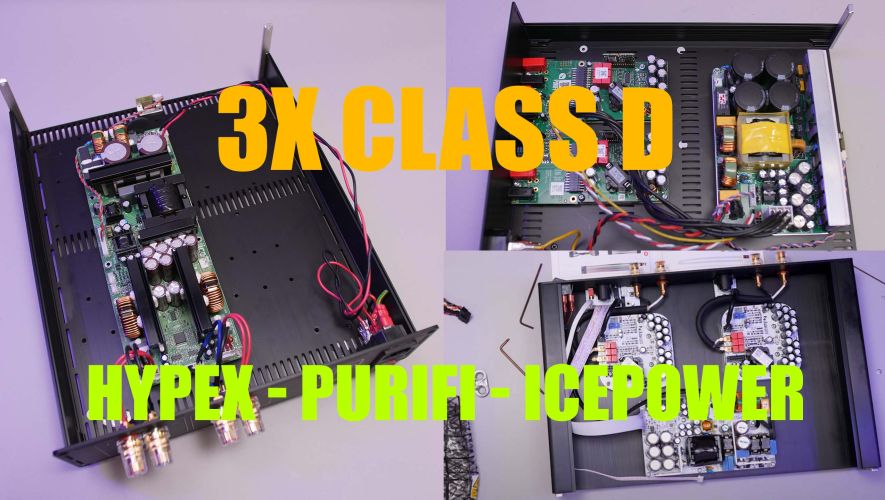

Intro
Contents
On Sunday, January 30, 2023, we held our first livestream of the year. And it was an interesting one; not that the other livestreams are not interesting by the way. We put three new generation Class D amplifiers side by side to determine how far Class D is now. Spoiler… it’s getting damn good!
Class D is not very popular with many purist enthusiasts. Class D is – they say – sharp, sterile, harsh…. just like digital audio. That also sounds flat and harsh. Right? Well… make no mistake. Both digital audio and Class D have made huge strides in recent years. Of course: UcD is no longer keeping up…. but nCore was a giant step Hypex made. And Purifi Eigentak was another substantial step in class D. Now we have arrived at the latest generation of Hypex: Nilai (and in a way nCoreX for the OEM product line). How does it compare to competitor Purifi Eigentakt? We explored it for you in this livestream. And to make it more complete: put ICEpower next to it.
Something about Class D
Let’s dispel one myth in advance: class D is NOT digital. Class D uses a different method – PWM: pulse width modulation – to amplify. Very simply explained, the power supply is either full open or full closed. By varying the length of open and close, the sine wave is recreated.
You will understand that the speed of opening and closing of the power supply determines the resolution and quality. And that the speed of the power supply itself (to follow that) also plays a crucial role. Faster really is better here. Hence the switching speed has increased enormously over the years. We are now around 500 kHz. There are even chips that operate at 1 GHz.
Another advantage of the higher switching speeds is the influence on the filter in the output of the amplifier. The “switching frequency” must be filtered out of the music signal. As well as some harmonics from it. Filtering is always tricky. Both in dacs and in amplifiers. The higher the switching frequency, the less influence the filter, because you can filter far outside the audio band.
You will see in measurements that modern class D amplifiers almost no longer apply filters that causes non-linearity in the audio band. Or suffer from impedance swings from speakers.
Purifi Eigentakt EVAL1
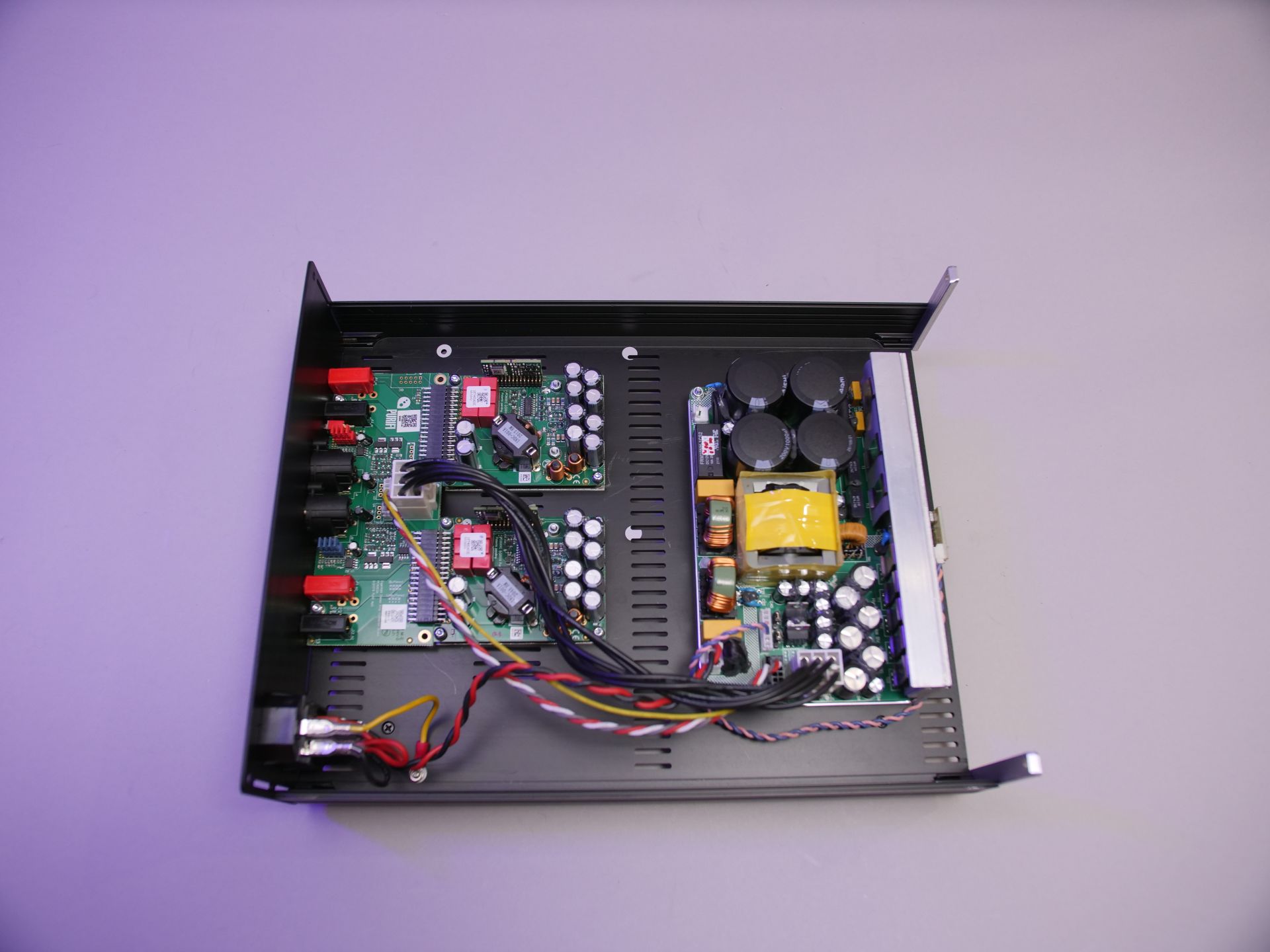
Purifi Eigentakt is definitely a revolution in class-D amplifiers. It sounds incredibly clean, powerful, dynamic and very well controlled. The well-known NAD amplifiers that use this technology are successes for a reason. They sound good and are competitively priced. And who doesn’t want that?
In this test, the Eigentakt proves again that it is a fine design. The sound is round, big and shows no sharpness. Also, the amp is incredibly fast which benefits the attack and PRaT. However, we do agree that the Eval1 emphasizes detail. And that it sometimes feels a bit like things are under a magnifying glass.
On Joep Beving’s ‘Hanging D’ piano piece – which we’ve christened ‘the amplifier killer’ – we hear that while the Eigentakt plays correctly, it can also be a bit thin. Also, the overflowing of tones into each other – which should be the case here – doesn’t quite match what you expect to hear. The whole thing seems to wobble a bit…. Know, however, that this is an incredibly difficult piece for virtually any piece of hi-fi equipment.
Massive Attack sounds solid again. The speed of the amplifier becomes very clear here as well. Everything is tight in our listening room, although it could be a little more spacious and with a little less “presence” on the T’s and S’s…. But for a product in this price range, it’s just incredibly good. Eigentakt shows that Class D is mature.
Measurements Eigentakt EVAL1
Eigentakt just measures tightly. We see a neat, straight response, a low noise floor and neat power measurements. While the power supply is good; Nilai’s is even quieter! The response is ruler flat and the distortion is very low. All in all… very decent measurements.
Hypex Nilai DIY
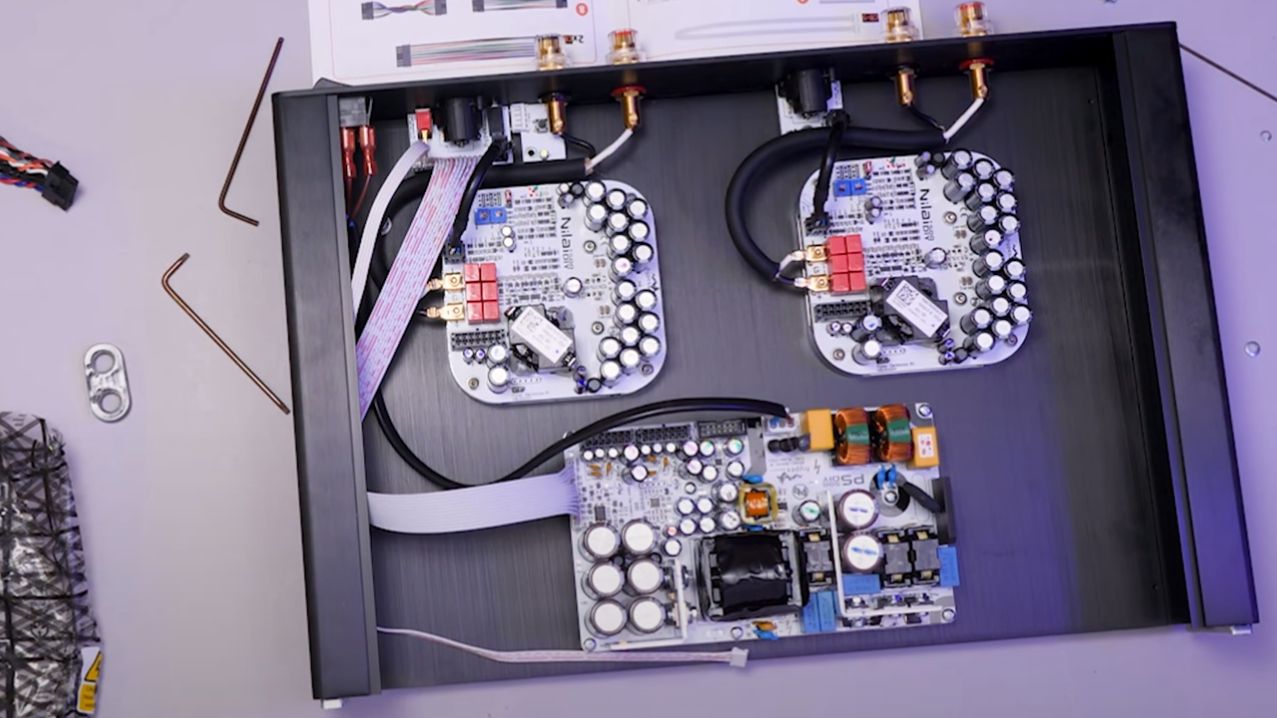
We were particularly curious about how big the difference between Eigentakt and Nilai can be. Probably not that big right? Two top tier producers…? Well… there is definitely a difference!
Surely Hypex Nilai plays a bit smoother and a bit more balanced (on our system) than Eigentakt. The low end is a bit more under control, it seems. That makes it less overwhelming and the mid and high get a little more space in the tonal spectrum. Now, we do not mean that the mids get pushed forward. On the contrary: the mids flow more and have more roundness. That also gives the instruments a bit more structure. Think of the guitar strings, cello and also vocals…
For Martijn the Nilai feels a bit slower. But that could also be calmness in the sound, although he writes that it’s more about the pacing. Both Geoffrey and Martijn agree on the tonality and tranquility of the Nilai. And the “depth” in the tonality. It is a very complete sounding amplifier that does not fail, even in Joep Beving’s piano piece it show authority. And that’s very impressive.
Measurements Hypex Nilai DIY
Hypex has not been sitting idle in recent years. The new generation not only sounds solid: it also measures very well. The response is straight, the noise floor is even a tick lower than Eigentakt. The power supply is also unprecedentedly quiet, we see on the spectrum analyzer. Distortion is low – even with small input signals – and power is achieved with ease…. and that’s an understatement.
ICEpower 700AS2
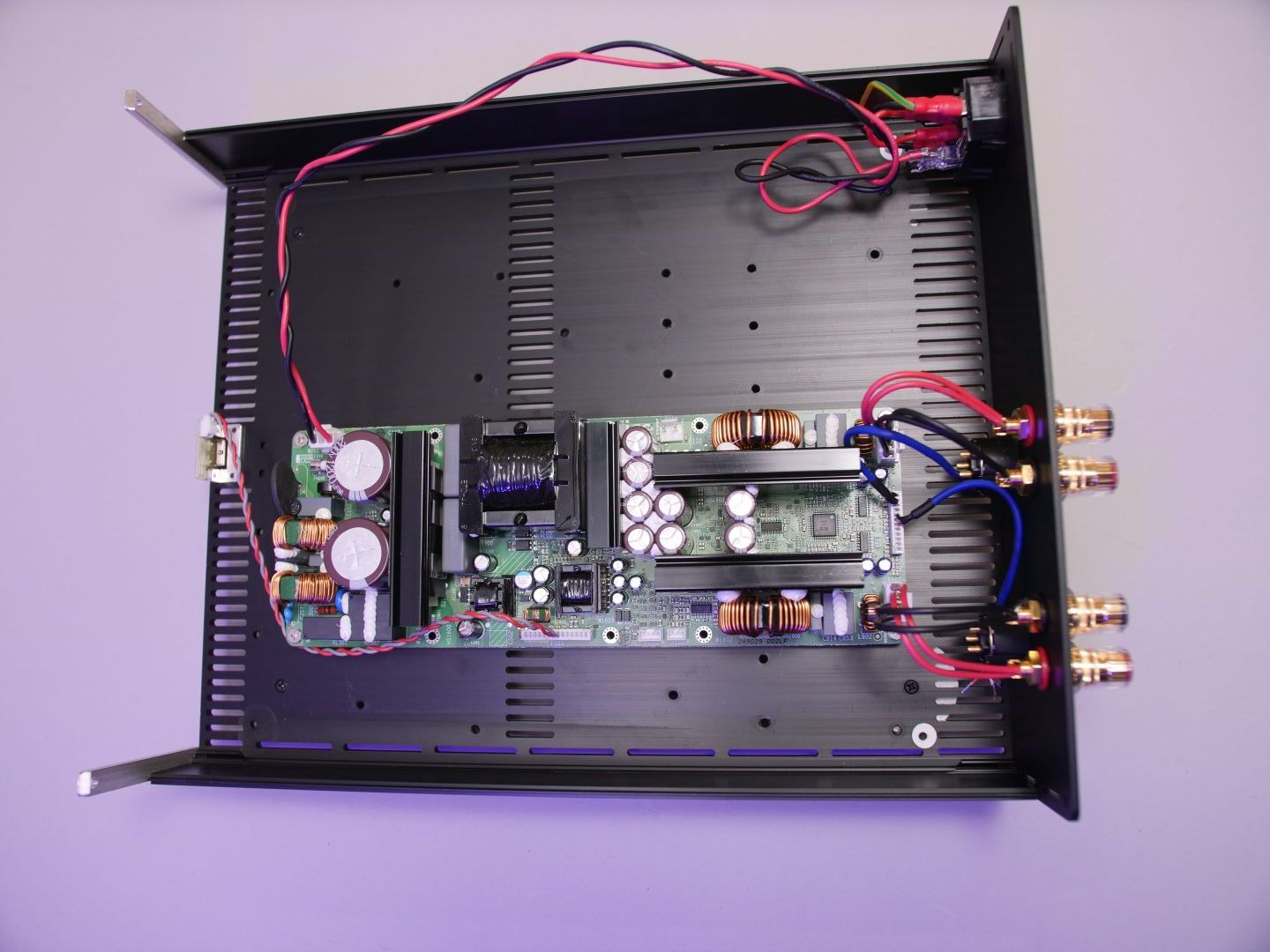
We’ve never tested an ICEpower DIY kit before. The 700AS2 costs a lot less than the Hypex and Purifi kits. Buying a serious amp for 849 Euros is a good deal. But don’t expect Hypex or Purifi quality. Because the ICEpower does not offer that.
The 700AS2 sounds a lot more intrusive and cluttered than its competitors. Vocals take on an edge and Joep Beving’s piano… well… that doesn’t sound correct at all: there are virtually no harmonics to be heard. It sounds staccato and rough if we are honest. Martijn says: it’s fast, but rough. Geoffrey agrees.
What does go well is detail in certain areas. Think of the voice area. Geoffrey even calls it “believable”. Also, the stereo image is big and rich. But not super precise. Not everyone is looking for that. Some enthusiasts just want to be embraced. And the ICEpower certainly does that. However, the stereo image – like Eigentakt – is more forward-facing. Hypex projects more toward the rear. Which is better is partly a matter of taste.
We do have to factor in price here. At 849 euros, the ICEpower costs just over half of the other two packages tested. So with this power amplifier you stay under 1000 euros, which is a limit for many DIY’ers … However, the following does apply: you get what you pay for. Hypex and Purifi just sound better.
Measurements ICEpower 700AS2
The measurements show in part why ICEpower sounds a bit rougher and messier. The noise floor is higher and also the response is not straight, indicating the influence of a filter. Channel separation is incredibly good. Better than the other two. The power supply, on the other hand, is less clean than we like to see. Still some peaks from the circuitry peaking up there. What is especially noticeable is the distortion at lower input signals. That’s where the microdetail does get lost. Both other contestants did significantly better there.





































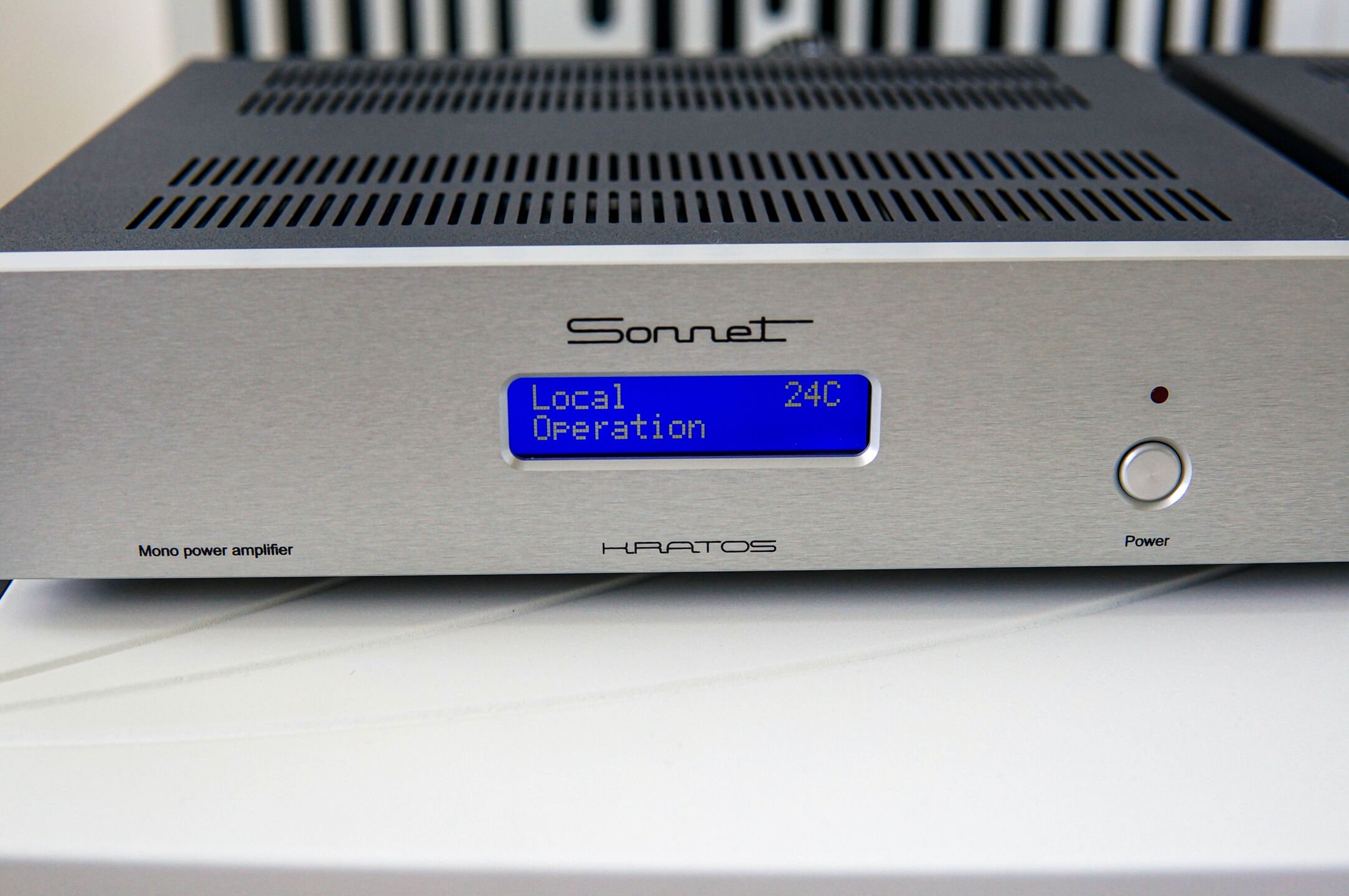
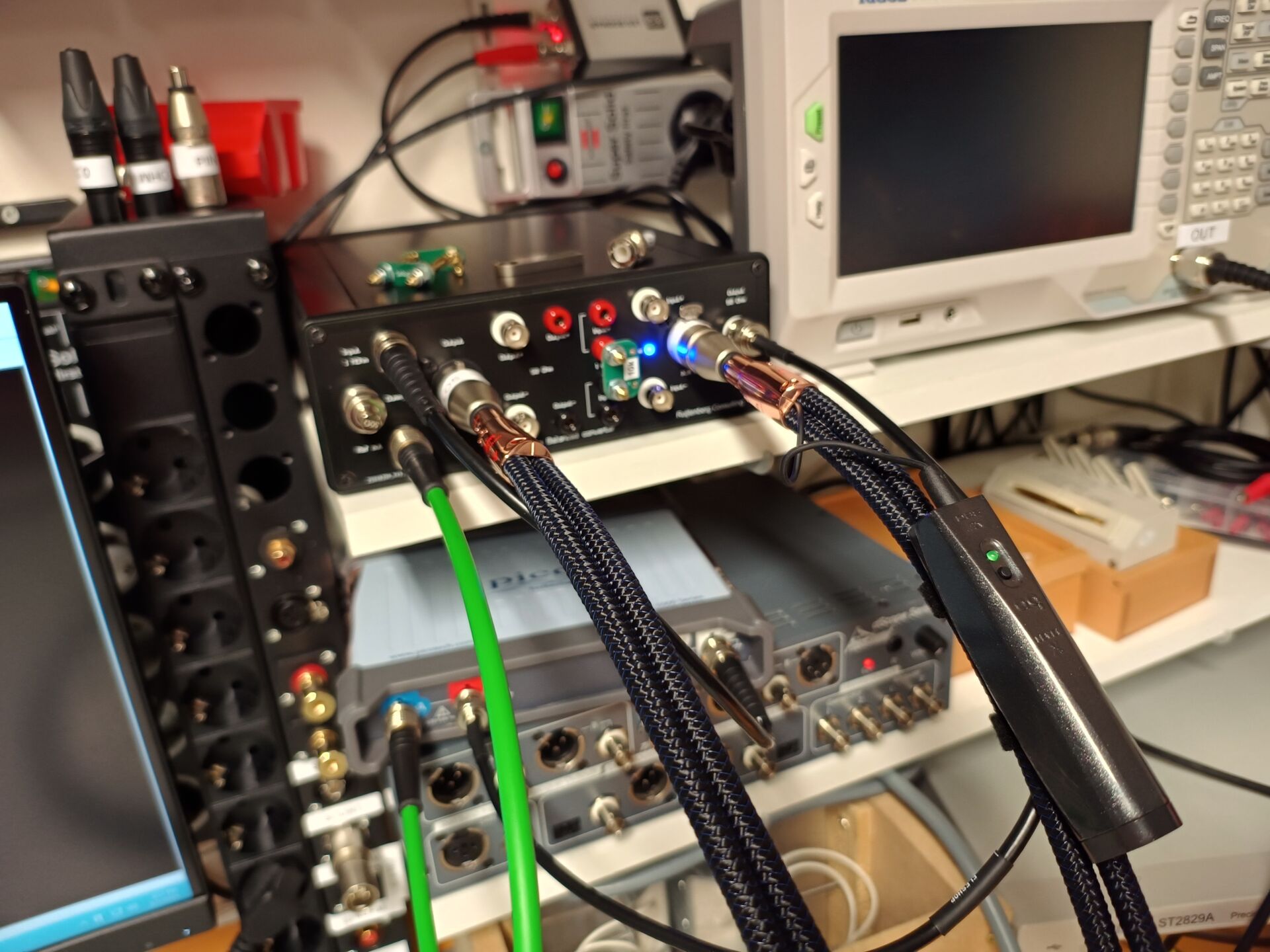
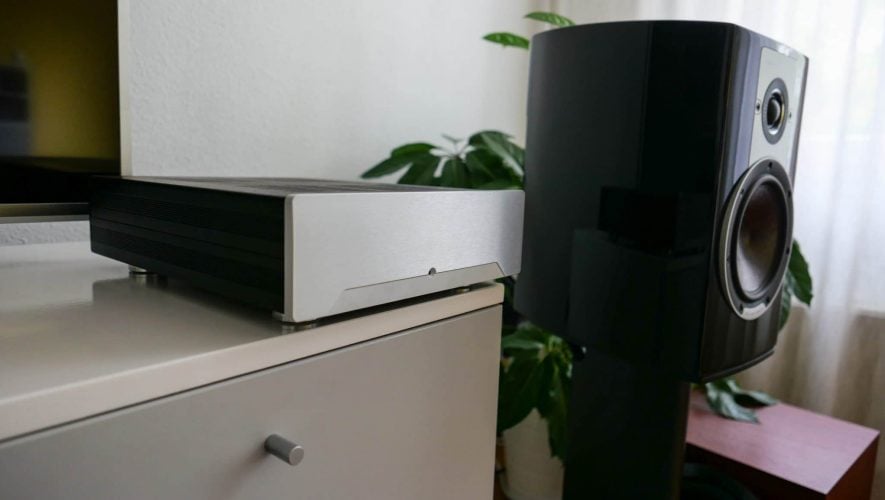
I loved the write up & the live stream..actually I enjoy a lot of the work you guys do. I’ve used some Class D in the past..UCD & then Ncore. Neither long term but the value for performance is quite good. I am a fan of the technology.
Due to the Class D shout-out video I’ve ordered a Nilai. Very excited to try this new technology. I already knew the objective data was stellar but I really appreciate the subjective thoughts from 3 guys that know quality audio components & sound. Their opinions have weight in my opinion.
I am a long time member at ASR. I love a lot of the work they do & I’ve learned a lot over the years. It’s a shame how a lot of it’s members treat others..a lot of anger at times. I just have to remind myself it’s mostly an engineering site. It’s not worth the argument or time to share any thoughts or opinions unless some data is involved. Members with more of an open mind aren’t going to share their thoughts in the forum. The hateful vultures with their $2k systems will attack. Is what it is..not worth the energy.
Anyway, you can’t let the haters & naysayers detract you from your journey. Keep up the good work.
Thanks for the comment. I deleted my account from ASR. Like you said: no open mind there. Alpha is very different. If I hear a difference, I want to know why and start investigating. And even if we dont find anything, the journey is still very interesting…
Does Martin mean reduced snappiness and attack when he mentions it is slower?
Not per se… Could also be transcient response or smearing.
In this case is the incredible low noise floor and sheer stability of the power, which results in a very tranquil and solid soundstage. Once the noise floor drops significantly and there is nothing in the sounds that distracts, the strange effect is that it feels ‘slower’, it is as less energy is fired at your ears. That’s true for every type of amplifier or set. Once the power gets better controlled (read: less noise) it makes you feel like the whole pacing of the music slows down.
There are a few exceptions to the rule, where the character of amplifier is still very snappy and on edge.
Thanks for both responses!
To me, a very low noise floor doesn’t make an amplifier slow, but ‘have a black background’. Noise makes localization a little bit more difficult and music less detailed in case of a high noise floor.
Distortion often detracts from tranquility and influence speed. It adds body, can seem faster but also add edginess and unrest.
For me speed is associated with timing and bandwith and maybe measurable with slew rate.
To me snappy seems a desirable trait while on edge is undesirable. Maybe apprehensive, although that can be both positive, want to know what comes next) and negative, afraid of what comes next?
I just gave you an explanation for the meaning of what is written in the article about the livestream we did. I am the listener on the couch and those are my words.
Another great listening test thanks guys. The difference between the Hypex and the others was clear enough via your youtube video and my ipad’s speakers. The Nilai’s greater naturalness, flow, harmonics and decay became even more pronounced replaying your flac files via good headphones.
After having dipped my toes into current gen Class D with the impressive Topping PA5, I’ve been close to pulling the trigger on one of NAD’s M23, but on the back of this test I just had to order a Hypex Nilai at less than half the cost. I look forward to pairing it with my Denafrips Athena and seeing how it goes.
As an aside, I am sorry you had to endure a couple of unkind and unwarranted comments over in a certain forum. I made the mistake of visiting it for the first time in a while to read about their Nilai measurement review, but the prevailing attitudes there are so deeply unpleasant and close-minded I would do better to avoid it entirely and suggest you might wish to do the same. The irony of banning discussion of your listening test which highlights easily audible differences between a group of very high measuring (SINAD etc) class D amps was next level, but alas terribly predictable, as it demonstrates the inadequacy of their suite of measurements to capture all an amplifier’s characteristics that produce audible differences relevant to human psycho-acoustic perception.
Please don’t let the attitude over there discourage you from continuing your great work – there are many of us who greatly appreciate the effort you put into producing high quality comparative listening tests and measurements, letting the results lie where they fall.
Salut!
Thanks Jacob! Appreciate your comment. The M23 is very nice, but in terms of price / performance the Nilai wins. Definately.
About ‘that forum’. The Class-D test was mild… the Switch-test is way worse. It made me decide I am going to delete my profile. These people are so narrow-minded, you can’t even have a normal discussion without them shouting nasty stuff. It’s mind blowing. I am not sure what it is. Maybe they are scared about being wrong? But what is so scary about being wrong? I was wrong about the influence of networks 6 years ago… but when I started hearing differences, it made me curious… It made me want to know what’s going on.
But enough about them. I’m glad we can help loads of other – open minded – people!
Another great listening test thanks guys. The difference between the Hypex and the others was clear enough via your youtube video and my ipad’s speakers. The Nilai’s greater naturalness, flow, harmonics and decay became even more pronounced replaying your flac files via good headphones.
After having dipped my toes into current gen Class D with the impressive Topping PA5, I’ve been close to pulling the trigger on one of NAD’s M23, but on the back of this test I just had to order a Hypex Nilai at less than half the cost. I look forward to pairing it with my Denafrips Athena and seeing how it goes.
As an aside, I am sorry you had to endure a couple of unkind and unwarranted comments over in a certain forum. I made the mistake of visiting it for the first time in a while to read about their Nilai measurement review, but the prevailing attitudes there are so deeply unpleasant and close-minded I would do better to avoid it entirely and suggest you might wish to do the same. The irony of banning discussion of your listening test which highlights easily audible differences between a group of very high measuring (SINAD etc) class D amps was next level, but alas terribly predictable, as it demonstrates the inadequacy of their suite of measurements to capture all an amplifier’s characteristics that produce audible differences relevant to human psycho-acoustic perception.
Please don’t let the attitude over there discourage you from continuing your great work – there are many of us who greatly appreciate the effort you put into producing high quality comparative listening tests and measurements, letting the results lie where they fall.
Salut!
Thanks Jacob! Appreciate your comment. The M23 is very nice, but in terms of price / performance the Nilai wins. Definately.
About ‘that forum’. The Class-D test was mild… the Switch-test is way worse. It made me decide I am going to delete my profile. These people are so narrow-minded, you can’t even have a normal discussion without them shouting nasty stuff. It’s mind blowing. I am not sure what it is. Maybe they are scared about being wrong? But what is so scary about being wrong? I was wrong about the influence of networks 6 years ago… but when I started hearing differences, it made me curious… It made me want to know what’s going on.
But enough about them. I’m glad we can help loads of other – open minded – people!